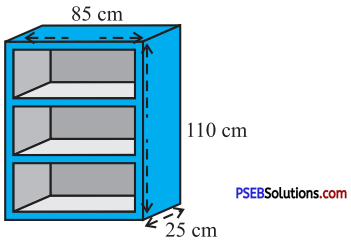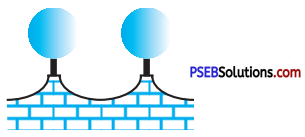Punjab State Board PSEB 9th Class Maths Book Solutions Chapter 13 Surface Areas and Volumes Ex 13.9 Textbook Exercise Questions and Answers.
PSEB Solutions for Class 9 Maths Chapter 13 Surface Areas and Volumes Ex 13.9
Question 1.
A wooden bookshelf has external dimensions as follows : Height =110 cm, Depth = 25 cm, Breadth = 85 cm (see the given figure). The thickness of the plank is 5 cm everywhere. The external faces are to be polished and the inner faces are to be painted. If the rate of polishing is 20paise per cm2 and the rate of painting is 10 paise per cm2, find the total expenses required for polishing and painting the surface of the bookshelf.

Answer:
Outer faces to be polished:
- One face on back side of the bookshelf, measuring 110 cm × 85 cm.
- Two faces on the sides, each of those measuring 110 cm × 25 cm.
- The top and the base, each of those measuring 85 cm × 25 cm.
- Two vertical strips on the front side, each of those measuring 110 cm × 5 cm.
- Four horizontal strips on the front side, each of those measuring 75 cm × 5 cm.
Thus, total area of region to be polished
= [(110 × 85) + 2(110 × 25) + 2 (85 × 25) + 2(110 × 5) + 4(75 × 5)] cm2
= (9350 + 5500 + 4250 + 1100+ 1500) cm2
= 21700 cm2
20 paise per cm2 = ₹ 0.20 per cm2
Cost of polishing 1 cm2 region = ₹ 0.20
∴ Cost of polishing 21700 cm2 region
= ₹ (21700 × 0.20)
= ₹ 4340
![]()
Inner faces to be painted:
- Two faces on the sides each of those measuring 90 cm × 20 cm.
- Two faces each of two shelves, the top face and the bottom face, in all six face, each of those measuring 75 cm × 20 cm.
- Face on the back side, measuring 90 cm × 75 cm.
Thus, total area of the region to be painted
= [2 (90 × 20) + 6 (75 × 20) + (90 × 75)] cm2
= (3600 + 9000 + 6750) cm2
= 19350 cm2
10 paise per cm2 = ₹0.10 per cm2
Cost of painting 1 cm2 region = ₹ 0.10
∴ Cost of painting 19350 cm2 region = ₹ (19350 × 0.10) = ₹ 1935
Then, the total expense of polishing and painting = ₹ 4340 + ₹ 1935 = ₹ 6275
![]()
Question 2.
The front compound wall of a house is decorated by wooden spheres of diameter 21 cm, placed on small supports as shown in the given figure. Eight such spheres are used for this purpose, and are to be ‘ painted silver. Each support is a cylinder of radius 1.5 cm and height 7 cm and is to be painted black. Find the cost of paint required if silver paint costs 25 paise per cm2 and black paint costs 5 paise per cm2.

Answer:
For each wooden sphere,
radius r = \(\frac{\text { diameter }}{2}\) = \(\frac{21}{2}\) cm
Curved surface area of 1 sphere
= 4πr2
= 4 × \(\frac{22}{7}\) × \(\frac{21}{2}\) × \(\frac{21}{2}\) cm2
= 1386 cm2
For each cylindrical support, radius r = 1.5 cm and height h = 7 cm.
Area of top of cylindrical support
= πr2
= \(\frac{22}{7}\) × 1.5 × 1.5 cm2
= 7.07 cm2 (approx.)
Hence, the area of each sphere to be painted silver = 1386 cm2 – 7.07 cm2 = 1378.93 cm2
∴ Total area of eight spheres to be painted silver = 1378.93 cm2 × 8 = 11031.44 cm2
25 paise per cm2 = ₹ 0.25 per cm2
Cost of painting silver in 1 cm2 region = ₹ 0.25
∴ Cost of painting silver in 11031.44 cm2 region
= ₹ (11031.44 x 0.25)
= ₹ 2757.86 (approx.)
Curved surface area of 1 cylindrical support
= 2πrh
= 2 × \(\frac{22}{7}\) × 1.5 × 7 cm
= 66 cm2
∴ Total area of eight cylindrical supports to be painted black = 66 cm2 × 8 = 528 cm2
5 paise per cm2 = ₹ 0.05 per cm2
Cost of painting black in 1 cm2 region = ₹ 0.05
∴ Cost of painting black in 528 cm2 region = ₹ (528 × 0.05)
= ₹ 26.40
Thus, the total cost of painting = ₹ 2757.86 + ₹ 26.40
= ₹ 2784.26 (approx.)
![]()
Question 3.
The diameter of a sphere is decreased by 25 %. By what per cent does its curved surface area decrease?
Answer:
Suppose, the initial diameter of the sphere is d units and radius is r units.
∴ d = 2r
Original curved surface area of the sphere
= 4πr2
= π (4r2)
= π (2r)2
= πd2 unit2
Now, the diameter of the sphere is reduced by 25 %. Hence, the new diameter of the sphere is 0.75d units.
New curved surface area of the sphere
= π (diameter)
= π (0.75d)2 unit2
= 0.5625 πd2 unit2
∴ The decrease in the curved surface area of the sphere = πd2 – 0.5625 πd2
= 0.4375 πd2 unit2
∴Percentage decrease in the curved surface area of the sphere = \(\frac{0.4375 \pi d^{2}}{\pi d^{2}}\) × 100 = 43.75 %
Thus, when the diameter of a sphere is decreased by 25 %, its curved surface area decreases by 43.75 %.